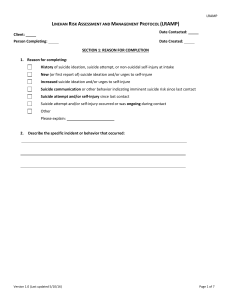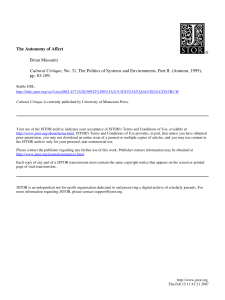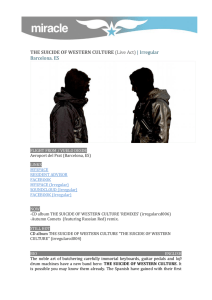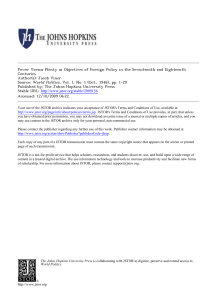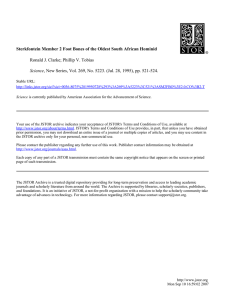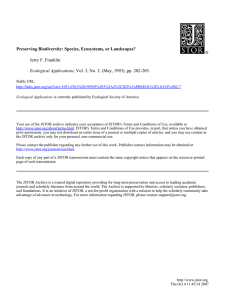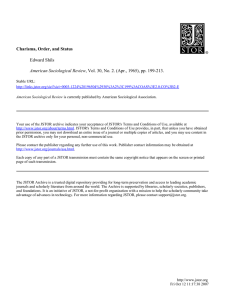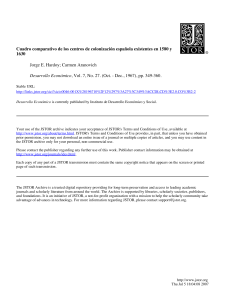Subido por
Andrea Garzón
Recurrent Suicidal Ideation in Young Adults
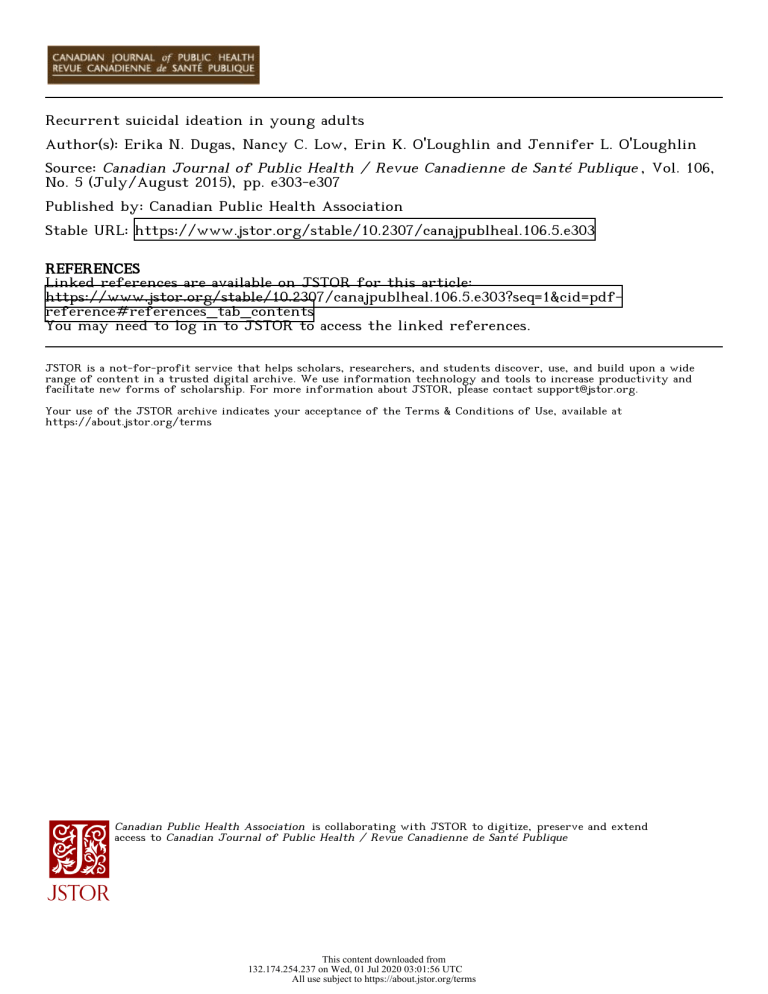
Recurrent suicidal ideation in young adults Author(s): Erika N. Dugas, Nancy C. Low, Erin K. O'Loughlin and Jennifer L. O'Loughlin Source: Canadian Journal of Public Health / Revue Canadienne de Santé Publique , Vol. 106, No. 5 (July/August 2015), pp. e303-e307 Published by: Canadian Public Health Association Stable URL: https://www.jstor.org/stable/10.2307/canajpublheal.106.5.e303 REFERENCES Linked references are available on JSTOR for this article: https://www.jstor.org/stable/10.2307/canajpublheal.106.5.e303?seq=1&cid=pdfreference#references_tab_contents You may need to log in to JSTOR to access the linked references. JSTOR is a not-for-profit service that helps scholars, researchers, and students discover, use, and build upon a wide range of content in a trusted digital archive. We use information technology and tools to increase productivity and facilitate new forms of scholarship. For more information about JSTOR, please contact [email protected]. Your use of the JSTOR archive indicates your acceptance of the Terms & Conditions of Use, available at https://about.jstor.org/terms Canadian Public Health Association is collaborating with JSTOR to digitize, preserve and extend access to Canadian Journal of Public Health / Revue Canadienne de Santé Publique This content downloaded from 132.174.254.237 on Wed, 01 Jul 2020 03:01:56 UTC All use subject to https://about.jstor.org/terms QUANTITATIVE RESEARCH Recurrent suicidal ideation in young adults Erika N. Dugas, MSc,1 Nancy C. Low, MD, MSc,2 Erin K. O’Loughlin, MA,1,3 Jennifer L. O’Loughlin, PhD1,4,5 ABSTRACT OBJECTIVES: Recurrent suicidal ideation (SI) may be linked to an increased risk of making suicide plans and suicide attempts. The objectives were to describe the frequency of SI recurrence in a population-based sample of young adults, and to compare mental health diagnoses, substance use, use of health services and medication use among those with and without recurrent SI. METHODS: Data were collected from 785 participants at age 20 years and again at age 24. Chi-square tests were used to compare participants with and without recurrent SI. RESULTS: Of 56 participants who reported SI at age 20, 32% reported SI four years later. Thirty-nine percent of participants with recurrent SI reported poor mental health compared to 8% of participants who never reported SI; 11% (vs. 4%) had sought professional help, 44% (vs. 8%) had been diagnosed with a mood and/or anxiety disorder, and 22% (vs. 2%) had taken medication for a mental health problem. Past-year substance use was higher among those with recurrent SI than among those with no SI: 67% vs. 42% smoked cigarettes, 56% vs. 39% used other tobacco products, 89% vs. 74% binge drank, 56% vs. 42% used marijuana and 33% vs. 17% reported using illicit drugs. CONCLUSION: One third of young adults with a history of SI reported SI four years later. Because SI can recur, clinicians should monitor young adults with a history of SI, assess their substance use and mood/anxiety disorders and if needed, refer them for psychological or psychiatric care. KEY WORDS: Longitudinal studies; suicidal ideation; young adult La traduction du résumé se trouve à la fin de l’article. S uicide is a leading cause of death among young people worldwide.1–3 Often defined as an indicator of severe emotional distress, suicidal ideation (SI) is one of the most robust predictors of self-harm, suicide attempts and completed suicide.2,4–6 SI that recurs over time could indicate ongoing severe depression7–9 and may be linked to an increased risk of making suicide plans and suicide attempts.5,10 However few longitudinal studies investigate recurrent SI in population-based samples10,11 and in particular among young adults in whom the prevalence may be elevated.7–9,12 Specifically, the developmental transition between adolescence and young adulthood represents a critical life period typically characterized by leaving the family home, joining the workforce, attending college or university, engaging in long-term relationships, and starting a new family.13 In those with a psychosocial, psychological, and/or genetic predisposition to mental health problems,8 these new social and environmental situations or stressors may lead to recurrent SI. Indeed, the frequency of SI is high during adolescence and young adulthood.2,3,8,14,15 A 2008 systematic review suggested that the 12-month prevalence estimates of SI are 15.0–29.0% (interquartile range [IQR], 16.9–24.1) in adolescents aged 12–17 years compared to 2.1–10.0% (IQR, 2.4–6.7) in adults ≥18 years.2 The lifetime prevalence estimates of SI in adults ≥18 years is 5.6–14.3%2 compared to 18% in young adults age 19–24 years.16 Because SI may evolve into a long-term mental state in some individuals, especially if untreated,11,17 it is important to better understand the extent to which young adults experience recurrent SI. © Canadian Public Health Association, 2015. All rights reserved. Can J Public Health 2015;106(5):e303–e307 doi: 10.17269/CJPH.106.4774 In addition to the lack of longitudinal population-based studies on recurrent SI in young adults, no study to date compares medication use, substance use (i.e., not substance use disorder), or use of mental health services in young adults with and without recurrent SI. Only one study has reported treatment and medication use among youth with recurrent mental health problems, but it does not describe SI.12 In order to extend the literature on recurrent SI, the objectives of the current study were to: 1) describe the frequency of recurrent SI over four years in a population-based sample of young adults, and 2) compare mental health diagnoses, substance use, and use of health services and medication among young adults with and without recurrent SI. Author Affiliations 1. Centre de recherche du Centre Hospitalier de l'Université de Montréal, Montreal, QC 2. Department of Psychiatry; Mental Health Service, Services for Students, McGill University, Montreal, QC 3. INDI Department, Concordia University, Montreal, QC 4. Department of Social and Preventive Medicine, University of Montreal, Montreal, QC 5. Institut national de santé publique du Québec, Montreal, QC Correspondence: Jennifer L. O'Loughlin, PhD, CRCHUM, 850 Saint-Denis (S02-370), Montreal, QC H2X 0A9, Tel: ☎514-890-8000, ext. 15858, E-mail: jennifer.oloughlin@ umontreal.ca Acknowledgements: Jennifer O'Loughlin holds a Canada Research Chair in the Early Determinants of Adult Chronic Disease. Erin O'Loughlin is funded by the Fondation CHU Sainte-Justine and the Fonds de recherche du Québec – Santé. The authors thank the NDIT participants and their parents. This work was supported by the Canadian Cancer Society (grants 010271, 017435). The funders were not involved in the design or conduct of the study; collection, management, analysis, or interpretation of the data; or preparation, review, or approval of the manuscript. Conflict of Interest: None to declare. CANADIAN JOURNAL OF PUBLIC HEALTH This content downloaded from 132.174.254.237 on Wed, 01 Jul 2020 03:01:56 UTC All use subject to https://about.jstor.org/terms . JULY/AUGUST 2015 e303 RECURRENT SUICIDAL IDEATION METHODS Sample Data were drawn from the Nicotine Dependence in Teens (NDIT) Study,18 a prospective cohort investigation of 1294 students recruited in 1999–2000 from all grade 7 classes (age 12–13 years) in a convenience sample of 10 secondary schools in Montreal, Quebec. The current analysis uses data collected in self-report questionnaires completed in 2007–2008 (n = 880) and 2011–12 (n = 858) when the participants were aged 20 and 24 years on average, respectively. Parents/guardians provided written informed consent at baseline, and participants (who had attained legal age) provided consent in the post-high school survey cycles. The study was approved by the Centre de Recherche du Centre Hospitalier de l’Université de Montréal Ethics Review Board. Study variables Suicidal Ideation Past-year SI was measured at age 20 years and again at 24 via the question: “In the past 12 months, how often did you feel suicidal?” Response choices included ‘never’, ‘less than once a month’, ‘1–3 times per month’, ‘1–6 times per week’, and ‘every day’. Participants were categorized as having recurrent SI if they gave any response other than ‘never’ at both age 20 and 24. Lifetime SI was measured only at age 24, via the question: “Have you ever seriously considered committing suicide or taking your own life?” (yes/no). This item was used to classify participants into three groups: i) participants who had never in their lifetime considered committing suicide; ii) participants with nonrecurrent SI (i.e., those who reported SI at age 20 but not at 24, and those who reported lifetime SI but no SI in the past 12 months at either age 20 or 24); and iii) participants with recurrent SI (i.e., participants who reported SI at both age 20 and 24). Mental Health and Substance Use Participants were asked at age 24 if they had sought psychological or psychiatric care in the past year (yes/no), if they had ever been diagnosed by a health professional with either a mood disorder (depression, bipolar disorder) or an anxiety disorder (phobia, fear of social situations, obsessive-compulsive disorder, panic disorder, generalized anxiety disorder), and if they had taken mood/ anxiety medications (i.e., anti-depressants (Prozac, Paxil, Effexor) and/or mood stabilizers (Lithium, Epival)) in the past month (yes/no). Participants also rated their mental health. Response choices to the question “In general, how would you rate…your mental health?” included ‘poor’, ‘fair’, ‘good’, ‘very good’ and ‘excellent’. For descriptive analyses, poor and fair mental health were combined into a single response category and compared to good/very good/excellent mental health. Past-year cigarette smoking was measured via: “Check the one box that describes you best…I have smoked cigarettes, but not at all in the past 12 months; I smoked cigarettes once or a couple of times in the past 12 months; I smoke cigarettes once or a couple of times each month; I smoke cigarettes once or a couple of times each week; I smoke cigarettes every day.” Use of other e304 REVUE CANADIENNE DE SANTÉ PUBLIQUE psychoactive substances was measured by: “In the past 12 months, how often did you … i) smoke cigars; ii) smoke cigarellos; iii) smoke a pipe; iv) use bidis (a tobacco product from India); v) use chewing tobacco; vi) use snuff; vii) use waterpipe (hubble bubble, nargilé, shisha); viii) drink 5 or more alcoholic beverages on one occasion (i.e., binge drinking); ix) use marijuana, cannabis, hashish; x) use cocaine; xi) use speed (amphetamines); xii) use ecstasy (MDMA) or other similar drugs; xiii) use hallucinogens (PCP, LSD (acid), mushrooms); xiv) use inhalants (glue, gasoline); xv) use heroin (smack, junk); and xvi) use another illicit drug (use of illicit drugs)?”. Response choices included ‘never’, ‘less than once a month’, ‘1–3 times per month’, ‘1–6 times per week’ and ‘every day’. Because of low frequency of use, we grouped cigars, cigarellos, pipe, bidis, chewing tobacco, snuff and waterpipe into a single variable labelled “other tobacco products”. Participants were categorized as yes (i.e., used one or more of these tobacco products in the past year) or no (i.e., did not use any of these tobacco products in the past year). Similarly, cocaine, speed, ecstasy, hallucinogens, inhalants, heroin and other illicit drugs were grouped into a single variable labelled “illicit drugs” (yes/no). Data analysis Differences in means were tested with t-tests and differences in proportion were tested with chi-square tests. Analyses were conducted using SPSS, Version 21.0 (IBM Corp. Released 2012. IBM SPSS Statistics for Windows, Version 21.0. Armonk, NY: IBM Corp.). RESULTS Among 795 participants with data available at age 20 and 24 years, 10 were missing data on the variables of interest. Therefore, complete data (i.e., no missing data on any study variable) were available for 785 participants (61% of the baseline sample of 1294). Table 1 compares selected characteristics of NDIT participants retained in this analysis with those of participants not retained, which includes the n = 221 who had dropped out of the study by age 20, and the n = 288 who did not complete a questionnaire either at age 20 or 24. A higher proportion of participants retained in the analysis were female and relatively more had mothers who were university-educated. While statistically significant, differences in age and Canadian-born (vs. foreign-born) were not substantively important. Table 1. Comparison of selected baseline characteristics of participants retained in the analysis with those of participants not retained (n = 1294), NDIT Study 1999–2012 Data on recurrent suicidal ideation Male, % Age at cohort inception, mean (SD) French-speaking, % Mother university-educated, % Canadian-born, % * From t-tests and chi-square tests. . VOL. 106, NO. 5 This content downloaded from 132.174.254.237 on Wed, 01 Jul 2020 03:01:56 UTC All use subject to https://about.jstor.org/terms No (n = 509) Yes (n = 785) p-value* 52.8 12.9 (0.6) 28.7 39.1 90.0 45.2 12.7 (0.5) 31.0 46.5 93.5 0.008 <0.001 0.396 0.038 0.021 RECURRENT SUICIDAL IDEATION Recurrent SI Substance use Seven percent and 9% of young adults reported past-year SI at age 20 and 24 years respectively, and 21% reported lifetime SI at age 24. Of 56 participants who reported past-year SI at age 20, 32% (n = 18) reported SI four years later (i.e., 2% of the overall sample). Compared to participants without SI, past-year substance use was relatively high among those with recurrent SI: 67% vs. 42% smoked cigarettes, 56% vs. 39% used other tobacco products, 89% vs. 74% binge drank, 56% vs. 42% used marijuana and 33% vs. 17% reported using illicit drugs (Table 2). Mental health diagnoses Table 2 describes mental health diagnoses, substance use, use of health services and use of medication among participants with no history of SI (i.e., people who reported no lifetime SI or pastyear SI at both age 20 and age 24), non-recurrent SI (i.e., people who reported SI at age 20 and not at age 24, as well as participants who reported lifetime SI but no ideation at either age 20 or age 24) and recurrent SI. Generally, relative to participants with no SI or non-recurrent SI, higher proportions of participants with recurrent SI were female (78% vs. 52% and 68% respectively) and relatively more reported poor/fair mental health (39% vs. 8% and 15% respectively). About one third of participants with recurrent SI had been diagnosed with a mood (39%) or anxiety (33%) disorder – a proportion that was higher than among participants with non-recurrent SI (27% and 20% respectively) and markedly higher than among participants without SI (4% and 7% respectively). Use of health services and medication Overall, few participants in this sample (i.e., 11% of those with recurrent SI, 12% of those with non-recurrent SI and 4% of participants without SI) had sought psychiatric help in the past year (Table 2). Twenty-two percent of participants with recurrent SI had taken mood/anxiety medication in the past month, compared to 5% of participants with non-recurrent SI and 2% of those with no lifetime SI. Table 2. Selected characteristics of participants with no lifetime suicidal ideation, non-recurrent suicidal ideation and recurrent suicidal ideation (n = 728*), NDIT Study 1999–2012 Suicidal ideation Never (n = 617) % Male Sought psychological help in past year Lifetime diagnosis of mood disorder Lifetime diagnosis of anxiety disorder Took mood/anxiety medication in past month Poor/fair mental health Smoked cigarettes past year Used other tobacco products past year Binge drank past year Used marijuana past year Used illicit drugs past year NonRecurrent precurrent (n = 18) % value‡ † (n = 93) % 48 4 32 12 22 11 0.003 0.001 4 27 39 <0.001 7 20 33 <0.001 2 5 22 <0.001 8 42 39 15 44 40 39 67 56 <0.001 0.112 0.384 74 42 17 73 51 23 89 56 33 0.343 0.147 0.085 * Excludes 2 participants with no data on lifetime suicidal ideation and 55 who reported suicidal ideation at age 24 years only. † Includes participants who reported suicidal ideation at age 20 and not at age 24, as well as participants who reported lifetime suicidal ideation but no suicidal ideation at either age 20 or age 24. ‡ Chi-square tests. DISCUSSION Comparison of the frequency of recurrent SI across studies is difficult because of differing study designs and populations, length of follow-up and, since there is no validated “gold standard” measure of SI,19 differing measurement items. Our population-based estimate of frequency (2% of the overall sample; 32% of those with a history of SI) is similar to the 3% and 25% of American college students respectively who reported more than one SI episode over four years.8 Similarly, Zivin et al.12 reported that 35% of college students with suicidal thoughts reported suicidal thoughts two years later. Borges et al.7 reported that 35% of American adults aged 25–65 years reported recurrent SI over ten years. The estimate of recurrent SI after one year was markedly higher in a Finnish study (69% of men and 59% of women aged 25–64 years),11 compared to only 6% among Chinese adults aged 20–59 years.10 Few participants with recurrent SI in this current study reported help-seeking behaviour in the past year. Possible reasons for not seeking professional help include, among others, perceived stigmatization (i.e., fear of what people think),20,21 fear of hospitalization, reluctance to share personal information about mental health problems, not accepting/admitting mental illness, limited access to services, and long waits for mental health services.17,22,23 In addition, young people often have a strong sense of self-determination and autonomy which influence their desire to manage problems on their own.17 In a recent review, Michelmore and Hindley17 reported that instead of seeking professional help, most youth with SI and/or self-harm behaviour turn to their social networks, most commonly their peers, for help. Although social networks can help people cope with stressful life events, friends and family often do not have the skills or experience to help those with serious mental health problems. Further, few encourage or are successful in encouraging their peers with SI to seek professional help.17,24 Community mental health promotion activities that facilitate social support and increase mental health literacy25 and easy access to mental health services may increase help-seeking behaviour in young people. Few participants in this study took mood or anxiety medications, which might relate to lack of consultation with health professionals for psychiatric conditions associated with SI or to perceived stigma associated with use of psychiatric medications. Because this may be the first time that medication is considered, young people may have heightened concerns about possible side effects such as weight gain, sedation, or sexual dysfunction. Rather than using medication prescribed by a health professional, young people – as is the case with other age groups – may use maladaptive coping styles such as substance use/misuse or avoidance to cope with problems.26 The high use of substances among those with SI in this study is consistent with existing reports7,27,28 in which youth use substances to cope with depression, anxiety and/or SI. CANADIAN JOURNAL OF PUBLIC HEALTH This content downloaded from 132.174.254.237 on Wed, 01 Jul 2020 03:01:56 UTC All use subject to https://about.jstor.org/terms . JULY/AUGUST 2015 e305 RECURRENT SUICIDAL IDEATION Our previous work suggested that depression symptoms as early as in grade 9 predicted SI at age 20.29 Interestingly, reports on SI recurrence suggest that higher levels of depression are not only associated with the risk of recurrent SI,8,10 but may also make young people with a history of SI more vulnerable to suicide attempts and completed suicide.10 Recurrent SI co-occurring with psychiatric disorders might reflect the severity of the mental illness and be associated with greater impairment in multiple areas of functioning, including academic, employment, social and personal.30 Additional factors associated with recurrent SI include higher life distress, anxiety, maternal depression, substance use and low levels of hope, social support and selfesteem.7,8,10,11 Early detection, treatment and monitoring of substance use and psychological factors, including depression, may prevent SI recurrence, and have the potential to reduce the burden of suicidality in young people.8 Limitations of this analysis include that the data on past-year SI were based on self-report and were drawn from a single item, and therefore may be subject to misclassification. Even though pastyear SI was measured with one item only, the item was asked in the same way at both age 20 and 24, which is an advantage. In addition, there was loss to follow-up since cohort inception. The small number of participants with recurrent SI precluded investigation of the determinants of recurrent SI. However, the prevalence estimates of past-year SI (i.e., 7% and 9% at age 20 and 24 years respectively) are consistent with the 7.7% reported in a nationally representative sample of Canadian youth age 18–19 years,31 and similar to the 6–13% in US reports of youth age 17–24 years.13,32,33 7. 8. 9. 10. 11. 12. 13. 14. 15. 16. 17. 18. 19. CONCLUSION One third of young adults with SI at age 20 reported SI four years later at age 24. Clinicians should assess substance use and mood and anxiety disorders among young adults with a history of SI and refer them for psychological or psychiatric care if needed. In addition, clinicians should routinely inquire about SI (among other indicators, including suicide attempts), since one in three people with SI continue to experience this symptom. 2. 3. 4. 5. 6. World Health Organization. Injuries and Violence: The Facts. Geneva, Switzerland: WHO Press, 2010. Available at: http://whqlibdoc.who.int/publications/2010/9789241599375_eng.pdf (Accessed June 23, 2014). Nock MK, Borges G, Bromet EJ, Cha CB, Kessler RC, Lee S. Suicide and suicidal behaviour. Epidemiol Rev 2008;30:133–54. PMID: 18653727. doi: 10.1093/ epirev/mxn002. Nock MK, Hwang I, Sampson N, Kessler RC, Angermeyer M, Beautrais A, et al. Cross-national analysis of the associations among mental disorders and suicidal behavior: Findings from the WHO World Mental Health Surveys. PLoS Med 2009;6(8):e1000123. PMID: 19668361. doi: 10.1371/journal.pmed. 1000123. Lewinsohn PM, Rohde P, Seeley JR. Psychosocial risk factors for future adolescent suicide attempts. J Consult Clin Psychol 1994;62(2):297–305. PMID: 8201067. doi: 10.1037//0022-006X.62.2.297. Kessler RC, Borges G, Walters EE. Prevalence of and risk factors for lifetime suicide attempts in the National Comorbidity Survey. Arch Gen Psychiatry 1999;56(7):617–26. PMID: 10401507. doi: 10.1001/archpsyc.56.7.617. Haavisto A, Sourander A, Multimäki P, Parkkola K, Santalahti P, Helenius H, et al. Factors associated with ideation and acts of deliberate self-harm among 18-year-old boys. A prospective 10-year follow-up study. Soc Psychiatry Psychiatr Epidemiol 2005;40(11):912–21. PMID: 16245189. doi: 10.1007/s00127-005-0966-2. e306 REVUE CANADIENNE DE SANTÉ PUBLIQUE 21. 22. 23. 24. REFERENCES 1. 20. 25. 26. 27. 28. 29. 30. Borges G, Angst J, Nock MK, Ruscio AM, Kessler RC. Risk factors for the incidence and persistence of suicide-related outcomes: A 10-year follow-up study using the National Comorbidity Surveys. J Affect Disord 2008;105(1–3): 25–33. PMID: 17507099. doi: 10.1016/j.jad.2007.01.036. Wilcox HC, Arria AM, Caldeira KM, Vincent KB, Pinchevsky GM, O’Grady KE. Prevalence and predictors of persistent suicide ideation, plans, and attempts during college. J Affect Disord 2010;127(1–3):287–94. PMID: 20471691. doi: 10.1016/j.jad.2010.04.017. Witte TK, Fitzpatrick KK, Joiner TE Jr, Schmidt NB. Variability in suicidal ideation: A better predictor of suicide attempts than intensity or duration of ideation? J Affect Disord 2005;88(2):131–36. PMID: 16054227. doi: 10.1016/j. jad.2005.05.019. Zhang Y, Law CK, Yip PS. Psychological factors associated with the incidence and persistence of suicidal ideation. J Affect Disord 2011;133(3):584–90. PMID: 21636133. doi: 10.1016/j.jad.2011.05.003. Hintikka J, Pesonen T, Saarinen P, Tanskanen A, Lehtonen J, Viinamäki H. Suicidal ideation in the Finnish general population. A 12-month follow-up study. Soc Psychiatry Psychiatr Epidemiol 2001;36(12):590–94. PMID: 11838830. doi: 10.1007/s127-001-8198-x. Zivin K, Eisenberg D, Gollust SE, Golberstein E. Persistence of mental health problems and needs in a college student population. J Affect Disord 2009;117(3):180–85. PMID: 19178949. doi: 10.1016/j.jad.2009.01.001. Arria AM, O’Grady KE, Caldeira KM, Vincent KB, Wilcox HC, Wish ED. Suicide ideation among college students: A multivariate analysis. Arch Suicide Res 2009;13(3):230–46. PMID: 19590997. doi: 10.1080/138111109030 44351. Bolger N, Downey G, Walker E, Steininger P. The onset of suicidal ideation in childhood and adolescence. J Youth Adolesc 1989;18(2):175–90. PMID: 24271685. doi: 10.1007/BF02138799. Patel V, Flisher AJ, Hetrick S, McGorry P. Mental health of young people: A global public-health challenge. Lancet 2007;369(9569):1302–13. PMID: 17434406. doi: 10.1016/S0140-6736(07)60368-7. Brezo J, Paris J, Barker ED, Tremblay R, Vitaro F, Zoccolillo M, et al. Natural history of suicidal behaviors in a population-based sample of young adults. Psychol Med 2007;37(11):1563–74. PMID: 17927844. doi: 10.1017/S0033291707 00058X. Michelmore L, Hindley P. Help-seeking for suicidal thoughts and self-harm in young people: A systematic review. Suicide Life Threat Behav 2012;42(5):507– 24. PMID: 22889130. doi: 10.1111/j.1943-278X.2012.00108.x. O’Loughlin J, Dugas EN, Brunet J, DiFranza J, Engert JC, Gervais A, et al. Cohort profile: The Nicotine Dependence in Teens (NDIT) Study. Int J Epidemiol 2014. pii: dyu135 (in press). PMID: 25022274. doi: 10.1093/ije/dyu135. Meyer RE, Salzman C, Youngstrom EA, Clayton PJ, Goodwin FK, Mann JJ, et al. Suicidality and risk of suicide–definition, drug safety concerns, and a necessary target for drug development: A brief report. J Clin Psychiatry 2010;71(8):1040–46. PMID: 20673551. doi: 10.4088/JCP.10cs06070ablu. Cook LJ. Striving to help college students with mental health issues. J Psychosoc Nurs Ment Health Serv 2007;45(4):40–44. PMID: 17477328. Room R. Stigma, social inequality and alcohol and drug use. Drug Alcohol Rev 2005;24(2):143–55. PMID: 16076584. doi: 10.1080/09595230500102434. Fortune S, Sinclair J, Hawton K. Help-seeking before and after episodes of selfharm: A descriptive study in school pupils in England. BMC Public Health 2008;8:369. PMID: 18947435. doi: 10.1186/1471-2458-8-369. Nada-Raja S, Morrison D, Skegg K. A population-based study of help-seeking for self-harm in young adults. Aust N Z J Psychiatry 2003;37(5):600–5. PMID: 14511089. doi: 10.1046/j.1440-1614.2003.01252.x. Curtis C. Youth perceptions of suicide and help-seeking: ‘They’d think I was weak or “mental”’. J Youth Stud 2010;13(6):699–715. doi: 10.1080/ 13676261003801747. Jorm AF. Mental health literacy. Public knowledge and beliefs about mental disorders. Br J Psychiatry 2000;177:396–401. PMID: 11059991. doi: 10.1192/bjp. 177.5.396. Crum RM, Mojtabai R, Lazareck S, Bolton JM, Robinson J, Sareen J, et al. A prospective assessment of reports of drinking to self-medicate mood symptoms with the incidence and persistence of alcohol dependence. JAMA Psychiatry 2013;70(7):718–26. PMID: 23636710. doi: 10.1001/jamapsychiatry.2013.1098. King RA, Schwab-Stone M, Flisher AJ, Greenwald S, Kramer RA, Goodman SH, et al. Psychosocial and risk behavior correlates of youth suicide attempts and suicidal ideation. J Am Acad Child Adolesc Psychiatry 2001;40(7):837–46. PMID: 11437023. doi: 10.1097/00004583-200107000-00019. Bukstein OG, Brent DA, Perper JA, Moritz G, Baugher M, Schweers J, et al. Risk factors for completed suicide among adolescents with a lifetime history of substance abuse: A case-control study. Acta Psychiatr Scand 1993;88(6):403–8. PMID: 8310846. doi: 10.1111/j.1600-0447.1993.tb03481.x. Dugas E, Low NCP, Rodriguez D, Burrows S, Contreras G, Chaiton M, et al. Early predictors of suicidal ideation in young adults. Can J Psychiatry 2012;57(7):429–36. PMID: 22762298. Trivedi MH, Morris DW, Wisniewski SR, Nierenberg AA, Gaynes BN, Kurian BT, et al. Clinical and sociodemographic characteristics associated . VOL. 106, NO. 5 This content downloaded from 132.174.254.237 on Wed, 01 Jul 2020 03:01:56 UTC All use subject to https://about.jstor.org/terms RECURRENT SUICIDAL IDEATION with suicidal ideation in depressed outpatients. Can J Psychiatry 2013;58(2): 113–22. PMID: 23442899. 31. Dupéré V, Leventhal T, Lacourse E. Neighborhood and poverty and suicidal thoughts and attempts in late adolescence. Psychol Med 2009;39(8):1295–306. PMID: 18845013. doi: 10.1017/S003329170800456X. 32. Barrios LC, Everett SA, Simon TR, Brener ND. Suicide ideation among US college students. Associations with other injury risk behaviors. J Am Coll Health 2000;48(5):229–33. PMID: 10778023. doi: 10.1080/07448480009599309. 33. Crow S, Eisenberg ME, Story M, Neumark-Sztainer D. Are body dissatisfaction, eating disturbance and body mass index predictors of suicidal behaviour in adolescents? A longitudinal study. J Consult Clin Psychol 2008;76(5):887–92. PMID: 18837605. doi: 10.1037/a0012783. Received: September 3, 2014 Accepted: April 26, 2015 RÉSUMÉ OBJECTIFS : L’idéation suicidaire (IS) récurrente peut être liée à un risque accru de faire des plans de suicide et des tentatives de suicide. Nous avons voulu décrire la fréquence de l’IS récurrente dans un échantillon populationnel de jeunes adultes et comparer les diagnostics de santé mentale, la consommation de substances, l’utilisation des services de santé et la consommation de médicaments chez les sujets avec et sans IS récurrente. RÉSULTATS : Sur les 56 participants ayant déclaré une IS à 20 ans, 32 % ont déclaré une IS quatre ans plus tard. Trente-neuf p. cent des participants ayant une IS récurrente ont dit avoir une mauvaise santé mentale, contre 8 % des participants n’ayant jamais déclaré d’IS; 11 % (c. 4 %) avaient cherché de l’aide professionnelle, 44 % (c. 8 %) avaient reçu un diagnostic de trouble de l’humeur et/ou de trouble anxieux, et 22 % (c. 2 %) avaient pris des médicaments pour un problème de santé mentale. La consommation de substances au cours de l’année écoulée était plus élevée chez les sujets ayant déclaré une IS récurrente que chez les sujets sans IS : 67 % c. 42 % fumaient la cigarette, 56 % c. 39 % consommaient d’autres produits du tabac, 89 % c. 74 % faisaient des excès occasionnels d’alcool, 56 % c. 42 % consommaient de la marijuana, et 33 % c. 17 % déclaraient avoir consommé des drogues illicites. CONCLUSION : Le tiers des jeunes adultes ayant des antécédents d’IS ont déclaré une IS quatre ans plus tard. Comme l’IS peut réapparaître, les cliniciens devraient surveiller les jeunes adultes ayant des antécédents d’IS, évaluer leur consommation de substances et leurs troubles de l’humeur/leur anxiété et, au besoin, les orienter vers des soins psychologiques ou psychiatriques. MOTS CLÉS : études longitudinales; idéation suicidaire; jeune adulte MÉTHODE : Les données ont été recueillies auprès de 785 participants à l’âge de 20 ans et de nouveau à l’âge de 24 ans. Des tests du khi-carré ont servi à comparer les participants avec et sans IS récurrente. CANADIAN JOURNAL OF PUBLIC HEALTH This content downloaded from 132.174.254.237 on Wed, 01 Jul 2020 03:01:56 UTC All use subject to https://about.jstor.org/terms . JULY/AUGUST 2015 e307


